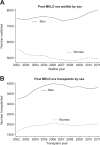Outcomes in liver transplantation: does sex matter?
- PMID: 25433162
- PMCID: PMC5935797
- DOI: 10.1016/j.jhep.2014.11.023
Outcomes in liver transplantation: does sex matter?
Abstract
A growing literature has highlighted important differences in transplant-related outcomes between men and women. In the United States there are fewer women than men on the liver transplant waitlist and women are two times less likely to receive a deceased or living-related liver transplant. Sex-based differences exist not only in waitlist but also in post-transplant outcomes, particularly in some specific liver diseases, such as hepatitis C. In the era of individualized medicine, recognition of these differences in the approach to pre and post-liver transplant care may impact short and long-term outcomes.
Keywords: Hepatitis C virus; Liver allocation; Liver transplantation; MELD score; Quality of life; Sex; Waitlist outcome; Women’s health.
Published by Elsevier B.V.
Conflict of interest statement
The authors declared that they do not have anything to disclose regarding funding or conflict of interest with respect to this manuscript.
Figures




References
-
-
In: Scientific registry of transplant recipients.
-
-
- Thuluvath PJ, Guidinger MK, Fung JJ, Johnson LB, Rayhill SC, Pelletier SJ. Liver transplantation in the United States, 1999–2008. Am J Transplant. 2010;10:1003–1019. - PubMed
-
- Hermann HC, Klapp BF, Danzer G, Papachristou C. Gender-specific differences associated with living donor liver transplantation: a review study. Liver Transpl. 2010;16:375–386. - PubMed
-
- Freeman RB, Jr, Wiesner RH, Harper A, McDiarmid SV, Lake J, Edwards E, et al. The new liver allocation system: moving toward evidence-based transplantation policy. Liver Transpl. 2002;8:851–858. - PubMed
Publication types
MeSH terms
Grants and funding
LinkOut - more resources
Full Text Sources
Other Literature Sources
Medical

